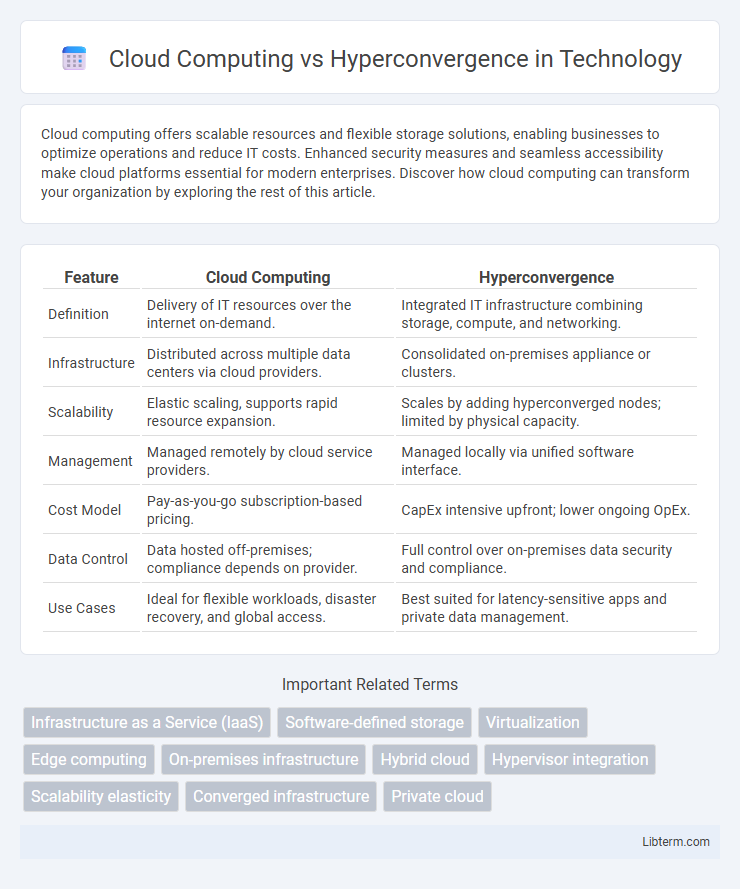Cloud computing offers scalable resources and flexible storage solutions, enabling businesses to optimize operations and reduce IT costs. Enhanced security measures and seamless accessibility make cloud platforms essential for modern enterprises. Discover how cloud computing can transform your organization by exploring the rest of this article.
Table of Comparison
| Feature | Cloud Computing | Hyperconvergence |
|---|---|---|
| Definition | Delivery of IT resources over the internet on-demand. | Integrated IT infrastructure combining storage, compute, and networking. |
| Infrastructure | Distributed across multiple data centers via cloud providers. | Consolidated on-premises appliance or clusters. |
| Scalability | Elastic scaling, supports rapid resource expansion. | Scales by adding hyperconverged nodes; limited by physical capacity. |
| Management | Managed remotely by cloud service providers. | Managed locally via unified software interface. |
| Cost Model | Pay-as-you-go subscription-based pricing. | CapEx intensive upfront; lower ongoing OpEx. |
| Data Control | Data hosted off-premises; compliance depends on provider. | Full control over on-premises data security and compliance. |
| Use Cases | Ideal for flexible workloads, disaster recovery, and global access. | Best suited for latency-sensitive apps and private data management. |
Introduction to Cloud Computing and Hyperconvergence
Cloud computing delivers on-demand access to shared computing resources such as servers, storage, and applications over the internet, enabling scalability and flexibility for businesses. Hyperconvergence integrates compute, storage, and networking into a unified system using software-defined architecture, simplifying management and improving efficiency. Both technologies support digital transformation but differ in deployment models and infrastructure approaches.
Core Principles: Cloud Computing Explained
Cloud computing delivers on-demand access to a shared pool of configurable computing resources such as servers, storage, and applications over the internet, enabling scalability and flexibility. Its core principles include resource pooling, on-demand self-service, broad network access, rapid elasticity, and measured service. This contrasts with hyperconvergence, which integrates compute, storage, and networking into a single system to optimize on-premises infrastructure performance and management.
Core Principles: Understanding Hyperconvergence
Hyperconvergence integrates compute, storage, and networking into a single software-driven system to simplify data center management and enhance scalability. Cloud computing offers on-demand access to shared resources over the internet, enabling flexible and scalable infrastructure without the need for physical hardware on-premises. Understanding hyperconvergence involves recognizing its core principle of converging hardware and software layers into unified platforms, contrasting with cloud's distributed and multi-tenant architecture.
Architecture Comparison: Cloud vs Hyperconverged Infrastructure
Cloud computing architecture leverages distributed networks and virtualized resources across multiple data centers to provide scalable, on-demand services via the internet. Hyperconverged infrastructure (HCI) integrates compute, storage, and networking into a single, software-defined system, optimizing resources within localized environments. While cloud architecture emphasizes elasticity and global accessibility, HCI focuses on simplifying management and enhancing performance through tightly integrated hardware and software stacks.
Scalability and Flexibility: Which Solution Wins?
Cloud computing offers unmatched scalability by dynamically allocating resources on-demand, accommodating fluctuating workloads without upfront infrastructure investments. Hyperconvergence provides flexibility through integrated compute, storage, and networking in a unified system, enabling seamless expansion via modular hardware additions. For enterprises prioritizing rapid scaling and global accessibility, cloud computing excels, while hyperconverged infrastructure suits organizations seeking localized control with flexible, incremental growth.
Performance and Reliability Considerations
Cloud computing offers scalable performance by leveraging distributed resources and on-demand provisioning, ensuring high availability through multi-region redundancy and automated failover mechanisms. Hyperconvergence integrates compute, storage, and networking in a single appliance with low latency, delivering consistent performance and simplified management for mission-critical workloads. Reliability in hyperconverged infrastructure depends on hardware resilience and local clustering, while cloud services rely on provider SLAs and global data center architectures.
Cost Analysis: TCO of Cloud vs Hyperconverged Systems
Total Cost of Ownership (TCO) for cloud computing often includes subscription fees, data transfer costs, and ongoing management expenses, while hyperconverged systems incur upfront capital expenditure for hardware along with maintenance and upgrade costs. Cloud platforms offer scalability that can reduce unnecessary overprovisioning, whereas hyperconverged infrastructure provides predictable fixed costs but may require overinvestment to handle peak loads. Analyzing TCO requires evaluating long-term operational expenses, scalability needs, and resource utilization efficiency to determine the most cost-effective solution between cloud services and hyperconverged systems.
Security Implications: Cloud vs Hyperconvergence
Cloud computing offers scalable security features like automated updates, encryption, and multi-factor authentication, though it faces challenges with data sovereignty and shared responsibility models. Hyperconvergence integrates computing, storage, and networking in a single system, enhancing security through localized control and reduced attack surfaces but may require more rigorous internal management. Evaluating these security implications depends on organizational needs for control, compliance, and risk tolerance in data protection strategies.
Use Cases and Deployment Scenarios
Cloud computing enables scalable applications and services by leveraging virtualized resources over the internet, ideal for dynamic workloads, disaster recovery, and multi-region deployments. Hyperconvergence integrates compute, storage, and networking into a single system, optimized for on-premises environments requiring simplified management, edge computing, and virtualization of legacy applications. Cloud suits organizations prioritizing flexibility and global reach, while hyperconvergence targets scenarios needing robust local performance and streamlined infrastructure.
Future Trends: Evolving Roles of Cloud and Hyperconvergence
Future trends reveal cloud computing increasingly integrating AI-driven automation and edge computing to deliver scalable, on-demand resources, while hyperconvergence evolves by enhancing infrastructure simplicity and performance through tightly coupled computing, storage, and networking in a single system. Enterprises adopt hybrid models leveraging cloud elasticity alongside hyperconverged infrastructure (HCI) for optimized workload management and reduced latency. This evolving synergy drives digital transformation by balancing the cloud's expansive reach with hyperconvergence's localized efficiency and control.
Cloud Computing Infographic

 libterm.com
libterm.com